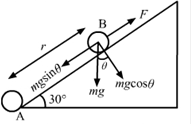A particle A having a charge of 2.0 × 10–6 C and a mass of 100g is placed at the bottom of a smooth inclined plane of inclination 30°. Where should another particle B, having same charge and mass, be placed on the incline so that it may remain in equilibrium?
Given:
Charge of the particle A and B: q1=q2= q = 2.0 × 10–6 C.
Mass of the particles A and B : m = 100 g =0.1 kg.
Inclination of the inclined plain : θ = 30°
Formula used:
The particle A and B will exert electrostatic repulsive forces on each other.
This can be given by Coulomb’s Law:
We use Coulomb’s law:![]() Where Fe is the electrostatic force on b due to A, k is a constant .
Where Fe is the electrostatic force on b due to A, k is a constant .
k = ![]() = 9× 109 Nm2C-2 and r is the distance between two charges.
= 9× 109 Nm2C-2 and r is the distance between two charges.
Particle B would face a friction force opposite to the rolling force due to inclination. It is given as:
F= mgsinθ
For particle B to remain in equilibrium with the inclination and particle A. The electrostatic force of repulsion and the friction force must be equal.
Fe = F![]()
![]()
![]()
![]()
![]() Hence, particle b must be place at a distance of 0.2701m from particle A to remain in equilibrium.
Hence, particle b must be place at a distance of 0.2701m from particle A to remain in equilibrium.